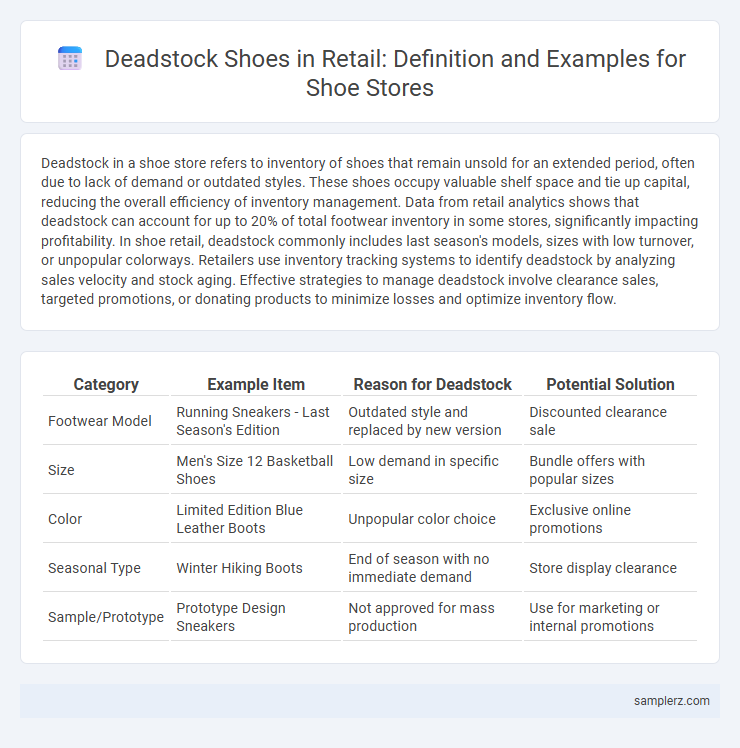Deadstock in a shoe store refers to inventory of shoes that remain unsold for an extended period, often due to lack of demand or outdated styles. These shoes occupy valuable shelf space and tie up capital, reducing the overall efficiency of inventory management. Data from retail analytics shows that deadstock can account for up to 20% of total footwear inventory in some stores, significantly impacting profitability. In shoe retail, deadstock commonly includes last season's models, sizes with low turnover, or unpopular colorways. Retailers use inventory tracking systems to identify deadstock by analyzing sales velocity and stock aging. Effective strategies to manage deadstock involve clearance sales, targeted promotions, or donating products to minimize losses and optimize inventory flow.
Table of Comparison
| Category | Example Item | Reason for Deadstock | Potential Solution |
|---|---|---|---|
| Footwear Model | Running Sneakers - Last Season's Edition | Outdated style and replaced by new version | Discounted clearance sale |
| Size | Men's Size 12 Basketball Shoes | Low demand in specific size | Bundle offers with popular sizes |
| Color | Limited Edition Blue Leather Boots | Unpopular color choice | Exclusive online promotions |
| Seasonal Type | Winter Hiking Boots | End of season with no immediate demand | Store display clearance |
| Sample/Prototype | Prototype Design Sneakers | Not approved for mass production | Use for marketing or internal promotions |
Common Causes of Deadstock in Shoe Stores
Deadstock in shoe stores often results from overproduction of unpopular sizes or styles, leading to unsold inventory that ties up capital. Seasonal trends that rapidly change cause certain shoe models to become obsolete before they are sold. Poor demand forecasting and inadequate market research frequently contribute to excess stock accumulation.
Identifying Deadstock: Signs in Retail Footwear
Deadstock in retail footwear refers to unsold inventory that remains in stock for an extended period, often characterized by outdated styles, excess quantities of specific sizes, and lack of customer demand. Key signs include prolonged shelf presence beyond seasonal trends, frequent markdowns without significant sales improvement, and minimal foot traffic interest for particular shoe models. Accurate identification of deadstock enables retailers to optimize inventory management, reduce holding costs, and implement effective clearance strategies.
Popular Shoe Models That Became Deadstock
Popular shoe models such as the Nike Air Yeezy 2 and Adidas Yeezy Boost 350 V2 became deadstock in many retail stores due to overproduction and shifting consumer trends. Despite high demand at release, limited resale value and market saturation contributed to these models remaining unsold for extended periods. Retailers often face challenges managing deadstock inventory of iconic sneakers, impacting overall profitability and inventory turnover rates.
Seasonal Shoe Inventory That Turns Into Deadstock
Seasonal shoe inventory often becomes deadstock when unsold models, such as winter boots or summer sandals, fail to move after the peak season ends, tying up valuable retail space. These unsold seasonal shoes lose relevance quickly due to changing fashion trends and shifting customer demand, making liquidation or deep discounting necessary. Efficient inventory management and accurate sales forecasting are critical to minimizing deadstock risks in shoe retail stores.
Impact of Overordering on Deadstock in Shoe Retail
Excess inventory in shoe retail often results from overordering popular or trend-sensitive models that fail to meet projected sales, leading to increased deadstock levels. Deadstock generates substantial holding costs and ties up capital, reducing cash flow necessary for new merchandise acquisition. Retailers facing high deadstock must implement demand forecasting improvements and inventory optimization strategies to mitigate financial losses and streamline stock turnover.
Limited Edition Shoes: Deadstock Risks and Rewards
Limited edition shoes often become deadstock in retail due to their niche appeal and fluctuating market demand, leading to unsold inventory that ties up capital. Retailers face risks like overestimating hype and production quantities, but rewards include higher profit margins and brand prestige when limited editions sell out. Effective inventory management and targeted marketing are crucial strategies for mitigating deadstock risks in this segment.
How Fashion Trends Create Deadstock in Footwear
Fashion trends in footwear shift rapidly, causing certain shoe designs to lose consumer interest and become deadstock in retail stores. Limited edition sneaker releases and seasonal colorways often fail to sell out if trends change unexpectedly, leaving retailers with excess inventory. Retailers must analyze trend data and consumer preferences closely to minimize deadstock and optimize stock turnover in shoe stores.
Deadstock Dilemmas: Managing Old Shoe Styles
Deadstock in shoe stores includes unworn, outdated sneaker models or seasonal footwear that failed to sell during peak demand. Managing these deadstock dilemmas requires strategic inventory clearance techniques such as flash sales, outlet discounts, or repurposing stock for limited releases to avoid revenue loss. Efficient handling of deadstock improves cash flow and mitigates the risk of storage-related costs in retail shoe inventory management.
The Role of Poor Marketing in Shoe Deadstock
Poor marketing strategies in shoe stores often lead to deadstock, where seasonal or trendy sneaker models fail to attract sufficient customer interest due to inadequate promotion. Lackluster advertising campaigns and ineffective targeted digital marketing result in overstocked inventory, causing financial losses and bulky storage issues. Retailers who neglect market research and fail to engage their audience through social media and influencer partnerships commonly experience increased volumes of unsold shoes languishing in warehouses.
Successful Strategies for Clearing Shoe Deadstock
Shoe stores often face deadstock challenges with outdated or unpopular models that linger on shelves, tying up valuable inventory space. Successful strategies for clearing shoe deadstock include targeted flash sales, collaborations with discount outlets, and leveraging online marketplaces to reach wider audiences. Implementing data-driven promotions and bundling slow-moving shoes with bestsellers can effectively reduce surplus inventory and maximize revenue recovery.

example of deadstock in shoe store Infographic
 samplerz.com
samplerz.com